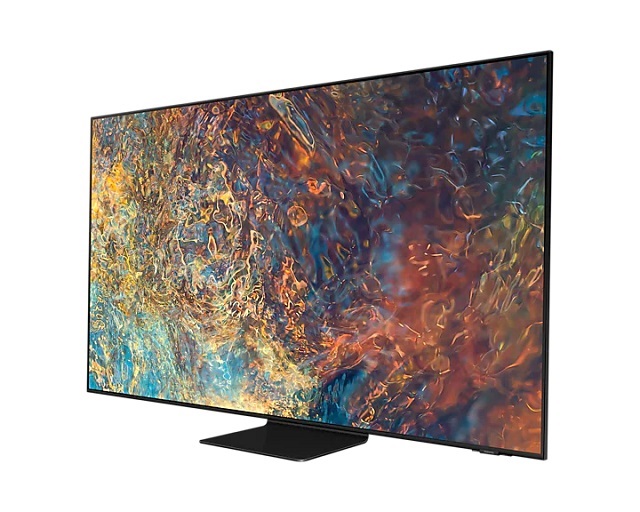Are you going to buy a TV, but unsure about what to do? Are you confused about selecting a QLED TV or an Ultra HD TV? When you purchase a new TV, you will usually come across both items. Can you use both of these? What is the meaning of them? So many questions will come to your mind while selecting any one of these. Let us know QLED vs UHD TV — What’s the Difference?
Mostly, QLED TVs, which you can see in the market today, are 4K TVs. All these televisions come with a minimum 4K resolution. However, it is said that you can get a 4K Ultra HD TV without QLED. The reason is that many daily LED-LCD and OLED TVs are available. Therefore, knowing why you should use them for QLED and Ultra HD will be better.
What is QLED?
Quantum Light-Emitting Diode or QLED is a specific LED backlight technology. It uses blue LED lights to generate color and target imagery via a Quantum Dot liquid crystal filter. This feature is one of the significant improvements on the earlier LED displays developed by Samsung in April 2017.
What is UHD?
Ultra-High Definition is a consumer marketing term developed by the Consumer Electronics Association of America. The primary purpose of this term is to make the marketing terms simple that is used for selling displays. It refers to a display with either 4k resolution or more than that. An average consumer should represent high clarity and quality.
The Meaning of QLED:
It is a kind of panel technology. Generally, the usual and entry-level models use daily light-emitting diode (LED) panels. But when it comes to this, you find quantum dots. Although white LEDs and color filters are used in conventional panels and have limited combinations, the diode panels emit colors separately. Quantum dots may be located at any place from 2nm to 10nm in diameter, and it is their sizes that let you know about the colors they emit.
For instance, blue tones focus on the smallest ones, whereas the large ones focus on red. In addition, quantum dots may create more defined and saturated colors than white LEDs.
There is no need to deal with colors that seem “watered down.”
Two technological ways are there to illuminate the quantum dots via these panels, and these are as follows – photo-luminescent and electroluminescent. However, you should note one thing: these recent diode panels should choose photo-luminescent illumination.
On the flip side, electroluminescent panels provide electricity to every quantum dot separately. As a result, every pixel is capable of making its respective light. If you combine this with ideal blacks and perfect colors, then it may be an excellent option for the future. However, the technology is now not ready for commercial purposes.
Backlight Bleeding:
However, these modern panels have a drawback: the backlight bleeding. You can use a mini-LED panel for this purpose because it is simple to use. The brighter image needs QLED panels to excel, and these require separate backlight instead of using every pixel and depending on their lights. It helps to offer an excellent HDR experience that offers enhanced brightness levels.
The color space has got an improvement for the QLED panels. However, if you increase the brightness levels, color saturation can suffer.
Above all, those who want to use a top-quality panel a bit more can go with the solution. It offers improved color performance and can be available at budget-friendly rates than premium panels.
People can use these for the technological middle ground.
Features of QLED:
The recent quantum technology offers some features that are as follows:
- Size: The bigger the size TV has, the better your experience. Having a larger TV indicates an improved immersive experience and better viewing. QLED televisions provide a clear benefit compared to OLED. QLED TVs come with different size options, and you can choose any of these according to your demand.
- Viewing Angle: The most favorable angle is front and center when it comes to viewing angles. But what if you have to sit far off to the center? Therefore, you should ensure that these offer a great viewing experience before buying. Those who prefer to enjoy movie nights with friends and family can go with this option. OLED displays can provide good image quality at the widest viewing angles. But the qled televisions may experience lost color and contrast. The far away you get from the center side, the more chance you will see in contrast. Manufacturers have changed major things, but still, it is not sufficient to beat the precise viewing angles.
- Response Time: Response time indicates the time required for a pixel to activate, deactivate, change, etc. It is measured in milliseconds in TV speak. Quick response time indicates that the picture on display will be crisper. Besides, it can react to color and light changes. You can see this in an action-packed chase scene.
More Features:
Qled TVs usually have less response time than OLED TVs, and the reason is that OLED pixels are capable of changing color and luminosity. Like qled TVs, these won’t wait for a backlight to shine through many display layers.
- Lifespan: The LED backlight in LCD TVs is reliable and long-lasting like QLEDs, and you can use the models for years before declining in quality.
- Energy Efficiency: The QLED TVs come with many staff that needs power, LED backlight, the quantum dot screen, and other layers. As a result, these become bulkier compared to OLED TVs, and it will make them less energy efficient also. The OLED TVs don’t have a backlight, but they use super-thin LED pixels, making them lighter, slimmer, and more energy-efficient.
- The Quantum Dots offer 100% Color Volume for brightness.
- Its Processor can improve the quality of shadow detail, contrast, and color accuracy.
- Netflix advised television, which supports voice assistants such as Google Home and Amazon Alexa.
The Meaning of UHD:
It is the resolution of the panel, while QLED is a technology. It means that the panel is available at 3840 x 2160 pixels. A few years ago, it was recommended to use a full HD TV for a limited budget. But now, it is trending. Awesome value-oriented UHD TVs are available like Series P from TCL. It comes with almost all features and offers an affordable price.
There are multiple apps and famous streaming services available in UHD.
Therefore, using these, you can get most features of your television. You can find this platform being marketed as 4K for its professional cinema standard. Besides, 4K has dimensions such as 4096 x 2160 separate from UHD.
From this “4K” fact, you learned that the horizontal resolution is very much near the 4 thousand pixels.
However, Ultra HD 4K TVs are now considered big-screen TVs for price and technology. For instance, you can see Samsung producing 4K QLED TVs, 4K LED TVs, Micro LED TVs, Neo QLED TVs, etc. Where “Ultra HD” means a 4K digital cinema standard, people consider the term “4K” to be used for consumer-grade TVs. For any television, 4K is a very common pixel resolution. You can find Ultra HD TVs using a panel with 3840 x 2160 pixels, and it is called 2160p and 4K as the pictures are almost 4,000 pixels wide.
Features of UHD:
- It is equipped with PurColor technology that uses plenty of color shades for a vibrant picture.
- The UHD offers boosted contrast for greater depth even in the brightest and dimmest scenes.
- It enables you to perform Connect & Share by syncing the television to supported mobiles. Thus, you can access and control the content on the large display.
Is Ultra HD necessary for you?
It is okay if you want to use a 32-inch TV in your bedroom. But if you are looking for a TV 40″ in size and larger, you will find the Ultra HD feature default.
Generally, the native 4K sources of content are very rare, and however, these are growing very fast. The native 4K content is available on TV streaming services like Amazon Prime Video, Netflix, Disney Plus, Hulu, Rakuten TV, etc. Besides, it is seen on Ultra HD Blu-ray Discs. In addition, you should know that the Apple TV 4K, PlayStation 4 Pro, PlayStation 5, and the Xbox Series X offer native 4K content.
How does QLED work? Is it different from OLED?
These televisions come with a ‘quantum dot’ filter. It consists of ultra-small semiconductor particles, enabling you to control them precisely. For example, you can control the filters for color output, and it helps to make a brighter image and a broader color spectrum.
Therefore, while choosing between a 4K LED TV and a 4K QLED TV, you should always go with the QLED TV. It is better based on color accuracy. Primarily Samsung sells QLED televisions, and it supplies these to TCL and Hisense.
What is Neo QLED? Mini LED? Micro LED?
Mini LED is the name of Samsung for something that plenty of television makers use. It was found in the 2021 TV range of Samsung. These televisions use a ‘micro layer’ over the backlight. With the help of the microlayer, it guides the Mini LEDs light via the similar quantum dots used in QLED televisions.
Micro LED is a new TV panel technology that is very expensive. Since 2018 when Samsung aired ‘The Wall’ Micro LED, it has been available. In the early stage of 2021, you can find Samsung’s Micro LED TV in different sizes— 110″, 99″ and 88″. The new panel technology uses pixel-sized LEDs to make brighter, higher-contrast pictures with reduced power.
Should you buy a 4K Ultra HD QLED TV?
If you are determined to use QLED, using Samsung’s best QLED TVs is better. For example, you can use Samsung Q80T QLED, available at $1,199 / £1,099, around AU$1,500.
If you are not bothered about this and only want to use a 4K TV, you should go with the best 4K TVs. Why because the best one will feature technologies such as QLED and OLED. Besides, it helps to encompass brands such as LG, Panasonic, Sony and Philips, Samsung, etc.
QLED vs UHD TV: Unveiling 5 Key Differences:
We have given here the difference, in a nutshell, to let you know the significant difference between QLED vs UHD.
When it comes to QLED technology, you can find it using an LED backlight. These hit quantum dot particles display and then charge the TV’s pixels for both color and brightness.
Televisions offering UHD resolution are higher than the standard LCD TV resolutions. Both types of televisions— OLED and QLED— provide UHD resolution.
UHD vs QLED TV:
Another thing you should know is that all the UHD panels are not qled. But all qled panels should be at least UHD. So it indicates that getting a QLED panel ensures that you will have UHD at least. Or you will get better than that, like 8K. However, a few panels use conventional LED panels, whereas a few premium ones go with OLED. But the vital thing that you should remember is that you might have both features in a single set.
Processor:
Usually, the Samsung QLED televisions offer robust processor designs— the Quantum Processor 4K and 8K. These help to enhance clarity, brightness, and sound. TVs that feature Samsung Crystal UHD technology offer a Crystal 4K processor, and it is optimized for color.
Image Resolution:
The Samsung UHDs feature Ultra Hi-Definition technology providing 4K viewing. In this case, the pixel number relies on the display size, offering either more or less clarity.
However, the QLED TVs provide more accurate colors and play 8K content. These enable you to turn on every pixel separately. As a result, you will get a perfect color reproduction. In addition, the light control entering every pixel lets you manage the saturation and brightness. Here, the intensity can go up to 4000 nits. The increased brightness level is remarkable while viewing television in broad daylight.
A few Samsung QLEDs that come with Direct Full Array HDR1500. It can boost brightness and manage the color gamut from light to dark tones. In addition, you can find the High Dynamic Range system for both models, used to calibrate black and white tones. Finally, the HDR10+ version is available in the Samsung UHDs, whereas QLEDs contain both HDR 10+ and Q HDR.
HDR experience is another major thing that you should consider. It has gained great fame in recent times because of which multiple consumers select them while choosing TVs. With the help of this high dynamic range, you can experience improved highlights and shadows. As a result, it offers an overall better image, mainly in scenarios with dark or bright parts.
Audio:
Both types come with the Q Series speakers and soundbars, which help create surround sound with the help of Q Symphony technology. In addition, there is an active voice amplifier used to control volume, and it enables you to hear the music even if a background noise exists.
You can get to see Adaptive Sound technology in both kinds of models.
Both Samsung’s QLED and Crystal UHD models have Adaptive Sound technology.
In this case, you get an optimized sound that helps to offer the best possible sound quality. Moreover, according to the TV channel, it can adjust the sound level.
QLED TVs feature Adaptive Sound+, an updated version of the Adaptive Sound technology, and it helps to enhance the sound quality and Audio Spatial Intelligence.
Therefore, according to the sound, QLED is the champion.
Gaming Experience:
Do you love to play video games? Then, you must go with Samsung’s QLEDs because these are an excellent choice for this. Multiple of these offer Game Enhancer+ and FreeSync technology to enhance the quality of image & sound.
On the flip side, Samsung’s Crystal UHD comes with a Game Enhancer of less updated versions. However, it offers a guarantee of fluid gameplay.
Price:
The Samsung UHD costs less, while the Samsung QLED costs more and offers advanced features. All these things rely on the quality of the picture that you need. Therefore, you should never forget your priorities. Choose according to the requirements and select one suitable for you most.
Which is better— QLED vs UHD?
Are you confused about selecting between UHD or QLED 4K? It is recommended to go with QLED 4K, and the reason is that it is brighter and offers improved color coverage compared to regular UHD.
The rare case is that UHD televisions come with a few unique features that don’t suit QLED models. Mostly, people buying QLED 4K offer good reviews. The
Samsung’s QLED TVs are designed with the help of cutting-edge technologies. Its function is to improve the image resolution and sound quality. However, you need to remember that the price is very high.
On the flip side, Crystal LED TVs have similarities with QLEDs, which are not so extensive. However, still, there are some excellent quality models available offering high performance at affordable cost. Therefore, it is completely your choice when select a TV for you.
Who Should Use UHD?
If you have a minimum of $500 or more, go with a UHD (4K) tv.
You must buy TVs with UHD at least as you have such a budget. For example, if you do not have a sufficient budget for 4K UHD but need television, use a cheaper 1080p option and upgrade later.
Similarities between UHD and QLED:
According to the recent market needs, the formats of the two televisions are similar, and it is because these can stand out for the thin screens.
As a remote control is available, people can easily access the TVs. The more devices you connect to your television, the better experience you will have. Multi-View technology exists for some models that enable you to view content on the mobile via voice assistant of choice. Various versions are available in the market, supporting different voice assistants like Google Home and Alexa.
These come with all connections relying on HDMI 2.0 or 2.1 ports, Wi-Fi, and Bluetooth. Generally, they don’t offer significant distinctions as per connectivity. However, the Universal Guide mode exists, and it makes sure that if you make a list with your favorite channels, it is easy to use. A Disney + app is there also, which enables you to see movies.
Ambiance Mode is available on both types of versions. As a result, you can select images to generate ambiance in your living room or bedroom. Samsung made the Tizen operating system suitable for both types of televisions.
What is Samsung QLED TV technology?
QLED means Quantum dot LED. Quantum dot technology is a feature available in television that makes it different from conventional LED TVs.
In QLED, Q stands for quantum dot. The small dots help create a layer in front of the backlight, generating colors displayed on display. Mostly, televisions use liquid crystals, and in this case, quantum dots indicate an additional layer.Samsung debuted the technology in 2016 after pioneering it. You may get the quantum dot screens available in all high-end sets.
According to the model name, a Samsung QLED can be spotted with a ‘Q.’ Some small brands make QLEDs also. However, Samsung is one of the four major manufacturers — LG, Panasonic, Samsung, and Sony— that make them. Quantum dots can create more vibrant colors and brighter images.
What is Samsung Neo QLED?
Samsung released its Neo QLED TVs first in 2021. These come with the same quantum dot technology as the standard QLED sets. However, the backlights feature small LEDs indicating better contrast and more control over the display parts. In addition, it helps to decrease blooming and light leakage where the highlighted sections of the image bleed into darker ones. Neo QLEDs come in thinner sizes because the LEDs are thinner also.
What is a Quantum Dot?
Quantum dots are created by nanocrystals consisting of ultra-fine semiconductor materials. Its main objective is to make different colors of light, but it relies on the particle size at that moment. So, for example, a bigger particle will be available as a red color, and the smaller the particle will be, the bluer it will be available.
These emit precise colored light for the particle sizes as these manage at quantum-level velocities. As a result, it can offer accurate and efficient light emissions, which is why QLED technology has similarities with tremendous improvements in overall image quality.
Quantum Processor in Samsung QLED TV?
It uses machine learning and AI, with the help of which it can upscale lower definition picture content to 4K or 8K quality. Thus, it can offer an improved viewing experience.
The Processor enables more precise control on the backlight dimming. It helps to distribute brightness and a boost to black in detail. In addition, it indicates that the TV’s brighter parts are brighter where the darker areas can showcase more information. Thus, it can help you to improve visibility at both ends of the spectrum.
What is Special About Samsung Qled TVs?
This type of television benefits multiple special features offered by quantum dots, and “high luminance” is one of them.
Luminance indicates how bright a display looks. Besides, brightness is an essential factor that affects other picture quality elements. When the brightness increases, the contrast ratio will improve naturally. If you find bright and dark representations of pictures & videos expressed widely, it is called HDR. High dynamic range is a significant component of picture quality.
The brightness effect on overall color quality is normal. For instance, the red color spectrum contains a range of bright and dark reds. However, the unique QLED technology and black implementation technologies (Direct Full Array) offer a different image quality. Besides, these can offer a more realistic viewing experience than non-QLED TVs.
The Bottom Line:
This article contains differences between Qled vs UHD. So you get to know what these are, their features, etc.
Frequently Asked Questions:
- What Are the Pros and Cons of QLED VS UHD?
You need to know that these are not adversarial terms. QLED is a technology developed by Samsung, whereas UHD is a term. As qled TVs are UHD, the benefits and drawbacks are similar.
- Is it worth buying QLED over UHD?
As qled televisions are ultra-high-definition, therefore when you buy a qled tv, it means you purchase a UHD tv. These can offer you an immersive home theater experience.
- Is QLED better than UHD?
No, it isn’t. First, you should know that qled is a technology type, whereas UHD refers to a consumer marketing term. This term indicates 4k resolution or higher than that, and QLED televisions are UHD TVs also.
- What is the difference between QLED and premium UHD?
Quantum dot TV technology is available in the qled, whereas the premium UHD is used in 4K range TV screens, which is the significant difference between these two. Premium UHD set up a consensus for the 4K Ultra HD specifications.
- Are QLED TVs expensive?
There are a few expensive models available. But mid-range models are there that don’t affect the budget.







